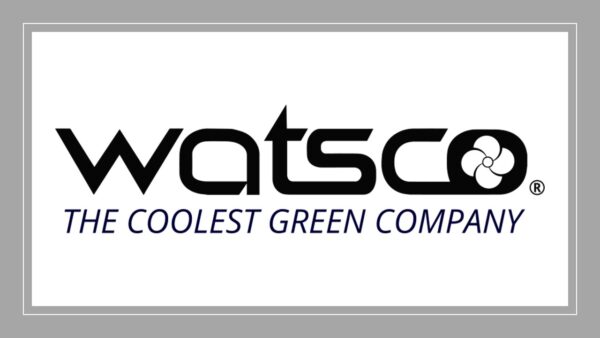We take a deep dive on the latest earning results from Lenox and WATSCO in this column.
HVAC manufacturer Lennox (light commercial equipment) and Watsco (distributor), and industrial manufacturer ABB, reported quarterly earning this week. Tariff discussions dominated the commentary both from the companies being proactive as well as questions from stakeholder analysts.
Lennox
In 1Q, demand for residential products was muted, with Lennox’s flat volumes offset by slight +2% price increases and +5% uplift from mix shift – the new refrigerant units. Lennox reported a 2% year-over-year increase in revenue, to $1.1 billion in the quarter, but a 7% decline in operating income, and profit margins declined 140 basis points. The company cited rising product and tariff-related costs weighing on profitability, which sent the stock price down. Despite these challenges, the company reaffirmed its full-year revenue guidance
Lennox raised expectations for higher prices (up to 6%) and lower volume expectations (declining a matching -6%), driven by a slowdown in new construction and consumer confidence softness.
Related, on April 11, Honeywell notified customers of a 42% price increase for R-454B, the new generation of refrigerant, citing rising raw material costs and anticipated tariffs. Whether these price increases will be passed onto OEMs depends on the contractual arrangements, with price increase primarily impacting those that did not enter longer term contractual price agreements
Lennox issued two price increases so far in 2Q: the first to offset changes in pricing for aluminum and copper and the second to offset the direct impact of tariffs. Lennox noted that of the two price increases, the first is a traditional price increase, while the second can be considered a surcharge and noted that it could potentially change.
Lennox believes that there may be a 2Q slowdown as inventory is depleted in a softer environment.
Lennox’s commercial segment (Building Climate Solutions) volumes declined 9% and were adversely impacted by the R-454B transition timing. During the call, Lennox noted that it encountered some customer order delays with the new R-454B product, but that order rates improved sequentially. This is on the back of weakening light commercial demand, which has consistently been slowing since fall 2024.
Meanwhile, the Building Climate Solutions segment saw revenue decline 6%, largely due to timing issues around customer transitions to lower GWP products and temporary manufacturing inefficiencies.
Lennox is well positioned to weather tariff pressures with its North America-focused business model and investments in supply chain durability. The majority of Lennox’s manufacturing and distribution is in the United States, providing the company with resilience and flexibility to win during tariff and regulatory uncertainty.
Indeed, about 5% of COGS are from China and about 90% of COGS in North America, so impacts from tariffs should be manageable. Lennox highlighted several initiatives to lower exposure to China and long-term tariff mitigation strategies, including:
- A joint venture with Samsung
- production shifts to better serve our US and Canadian customers.
- Working closely with our supply partners on tariff sharing models
- Leveraging more US based components to enhance flexibility within the North American network.
- Anything not mitigated through these measures is being offset by pricing adjustments or surcharges.
- Continue to invest in supply chain with increased manufacturing capacity
- Dual sourcing key components.
Watsco
Watsco, the largest US residential HVAC distributor, serves over 375,000 contractors, technicians and installers.
In 1Q25, overall sales declined 2%, which was a notable miss, which underneath, represents a complex mix of old and new technology transition, experiencing varying levels of demand across end markets and geographies.
Watsco’s core U.S. market for residential replacement sales increased 10%, reflecting new customer acquisition, unit growth, price-capture and an improved mix of higher-efficiency products, along with improved gross margins. This contrasts with a 9% decline in sales to international markets, Canada and Mexico, lower volumes related to new housing markets (declined 10%) and a disparity in certain end-markets on the timing and cadence of the A2L refrigerant product transition – overall commercial markets were down 10%.
While still early in the selling season, recent sales and margin trends have improved and the Company expects more resilient demand during the seasonally stronger periods as the first quarter in HVAC tends to be seasonally the smallest.
Watsco maintains a strong balance sheet, despite the revenue hit. Cash flow was healthy, and in fact the company invested $178 million in new A2L products ahead of the spring selling season.
Watsco highlighted several competitive advantages, among them:
- Technology – Watsco’s technology and e-commerce platform users produce higher growth rates and exhibit approximately 60% less attrition. Adoption of digital solutions by more contractors will aid future growth and profitability and ultimately lower the overall cost to serve customers. In addition, Watsco invests in internal technologies with the goal of further enhancing margins and improving operating efficiencies.
- Buy and Build Acquisition Strategy - Watsco has partnered with more than 70 independent distributors who have chosen to join the Watsco family, contributing to the Company’s scale and, more importantly, its community of seasoned leaders. Since 2019, Watsco has acquired 11 companies that represent $1.6 billion in sales across 113 locations.
- Scale and Product Depth - Watsco operates the largest HVAC/R network across North America, consisting of 693 locations that support more than 130,000 contractor customers. Watsco also possesses the broadest and deepest assortment of products in the industry to support those customers with approximately $1.8 billion in inventory across 200,000 SKUs produced by over 20 equipment OEMs and more than 1,500 non-equipment vendors.
The scale and reach, coupled with Watsco’s growing digital presence, are key differentiators given the fragmented nature of our industry, allowing Watsco to compete effectively in any macroeconomic environment.
As always, we appreciate your support, comments, and consideration.
